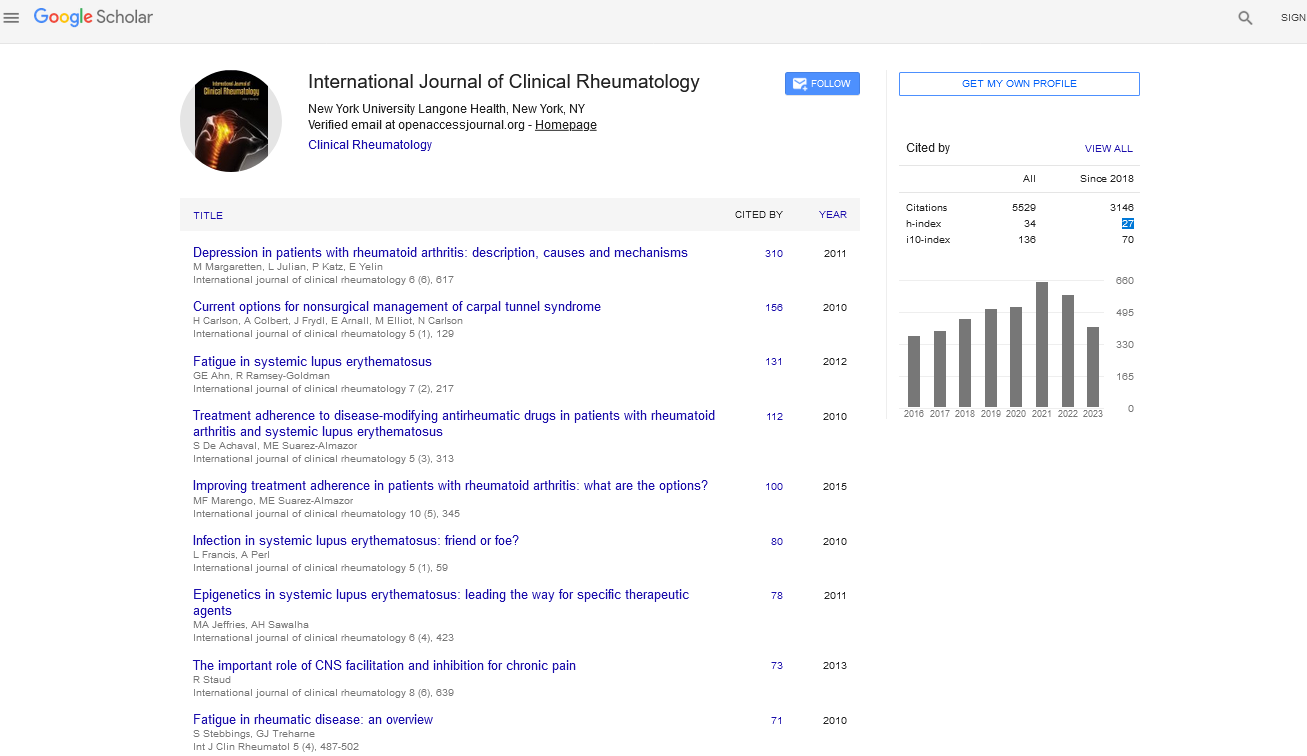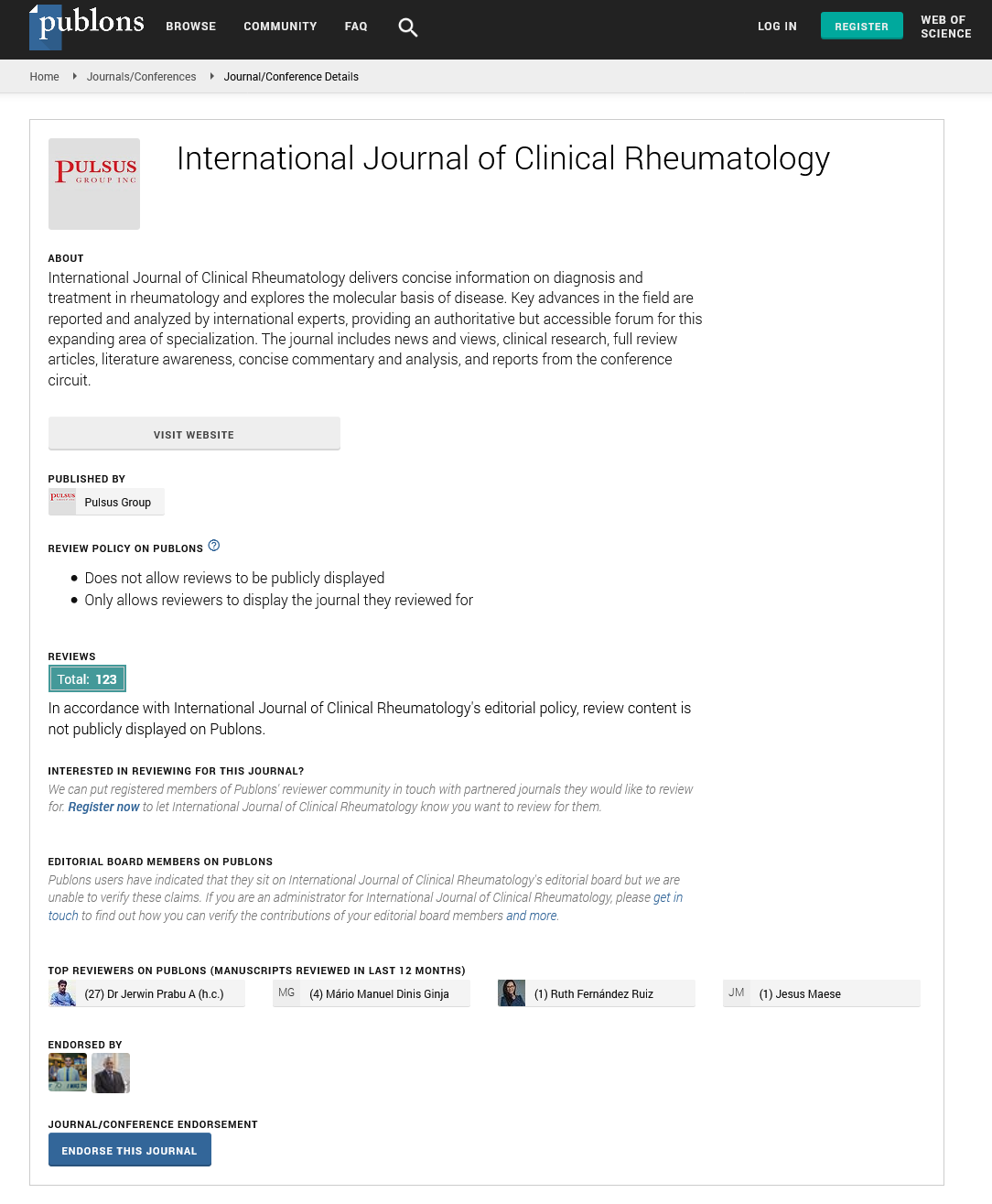Perspective - International Journal of Clinical Rheumatology (2025) Volume 20, Issue 1
The Role of Targeted Therapy in Systemic Lupus Erythematosus: Current Advances and Future Perspectives
David Brooks*
Division of Rheumatology, University of São Paulo, São Paulo, Brazil
- *Corresponding Author:
- David Brooks
Division of Rheumatology, University of São Paulo, São Paulo, Brazil
E-mail: david.brooks1985@outlook.com
Received: 02-Jan-2025, Manuscript No. fmijcr-25-162975; Editor assigned: 04- Jan-2025, Pre-QC No. fmijcr-25-162975 (PQ); Reviewed: 18-Jan-2025, QC No. fmijcr-25-162975; Revised: 23-Jan-2025, Manuscript No. fmijcr-25-162975 (R); Published: 30-Jan-2025, DOI: 10.37532/1758- 4272.2025.20(1).402-405
Abstract
Systemic lupus erythematosus (SLE) is a chronic autoimmune disease characterized by multi-organ inflammation and immune system dysfunction. Despite significant advancements in the treatment of SLE, many patients still experience disease flares, irreversible organ damage, and poor long-term outcomes. The treatment of SLE has historically relied on nonspecific immunosuppressive agents, such as corticosteroids and antimalarials, which provide symptomatic relief but do not directly target the underlying immune dysregulation. Over the past decade, the advent of targeted therapies has transformed the management of SLE, offering more specific mechanisms of action and potentially fewer side effects. This article reviews the role of targeted therapies in the treatment of SLE, with a focus on biologic agents, Janus kinase (JAK) inhibitors, and other innovative treatments. We also explore the challenges and future directions of targeted therapy in SLE, including personalized medicine approaches and ongoing clinical trials.
Keywords
Systemic lupus erythematosus• Targeted therapy• Biologics• JAK inhibitors• Immune dysregulation• Personalized medicine• Immunosuppressive therapy• Clinical trials
Introduction
Systemic lupus erythematosus (SLE) is a complex autoimmune disease characterized by a loss of immune tolerance, leading to the production of autoantibodies that target various tissues, including the skin, kidneys, joints, and cardiovascular system. The etiology of SLE is multifactorial, involving genetic, environmental, and hormonal factors that trigger immune activation and inflammation. SLE is often diagnosed in young women, with a peak incidence in individuals between the ages of 15 and 45. The disease is marked by periods of remission and relapse, making management particularly challenging. Traditionally, the treatment of SLE has relied on broad immunosuppressive therapies, including corticosteroids, antimalarials, and cytotoxic drugs. These treatments aim to suppress the overactive immune system, but they come with significant side effects, including increased susceptibility to infections, osteoporosis, and cardiovascular complications. Furthermore, conventional treatments are not disease-specific and do not address the underlying immune dysregulation. In recent years, there has been significant progress in the development of targeted therapies for SLE. These therapies are designed to modulate specific components of the immune system that contribute to disease pathogenesis. Biologic agents, such as monoclonal antibodies, and small molecule inhibitors, such as Janus kinase (JAK) inhibitors, are at the forefront of this new era in SLE management. This article reviews the current advancements in targeted therapies for SLE, their mechanisms of action, clinical outcomes, and future directions for research and treatment [1-6].
Biologic agents in SLE treatment
Biologic therapies have emerged as one of the most promising advances in the treatment of SLE. These therapies aim to selectively target immune pathways involved in the pathogenesis of SLE, including B cell activation, type I interferon (IFN) signaling, and T cell-mediated inflammation.
Belimumab (Benlysta): Belimumab is a monoclonal antibody that inhibits B lymphocyte stimulator (BLyS), a protein essential for B cell survival and differentiation. By blocking BLyS, belimumab reduces the number of autoreactive B cells that produce pathogenic autoantibodies in SLE. Belimumab was the first biologic agent approved by the FDA for SLE in 2011 and has been shown to reduce disease activity, prevent flares, and improve overall disease management. Clinical trials have demonstrated that belimumab, in combination with standard immunosuppressive therapy, provides greater efficacy than standard treatments alone, particularly in patients with active SLE who have high titers of autoantibodies.
Rituximab (Rituxan): Rituximab is a chimeric monoclonal antibody targeting CD20 on B cells. By depleting B cells, rituximab reduces the production of autoantibodies and inflammatory cytokines. While rituximab is not FDA-approved specifically for SLE, it has been used off-label in patients with refractory disease. Clinical studies suggest that rituximab may be effective in patients with severe disease manifestations, such as lupus nephritis, though it is associated with potential risks, including infusion reactions and increased susceptibility to infections.
Anifrolumab (Saphnelo): Anifrolumab is a monoclonal antibody that inhibits the type I interferon receptor. Type I interferons play a central role in the pathogenesis of SLE by promoting immune activation and inflammation. Anifrolumab has shown promise in reducing disease activity in patients with moderate-to-severe SLE, especially those with a high interferon signature. In clinical trials, anifrolumab has been associated with improvements in disease activity scores, skin involvement, and corticosteroid use reduction. It was recently approved by the FDA in 2021 for the treatment of moderate-to-severe SLE.
Janus Kinase (JAK) Inhibitors in SLE
Janus kinase inhibitors are small molecules that target intracellular signaling pathways involved in the activation of immune cells. JAK inhibitors work by blocking the activity of JAKs, enzymes that mediate the signaling of various cytokines, including interleukins and interferons, that contribute to autoimmune inflammation. JAK inhibitors are increasingly being explored as therapeutic options in SLE due to their ability to modulate multiple immune pathways simultaneously.
Tofacitinib (Xeljanz): Tofacitinib is a JAK inhibitor that has been approved for the treatment of rheumatoid arthritis and is being investigated for its potential role in SLE. Early-phase clinical trials have shown that tofacitinib may reduce disease activity and improve skin and joint involvement in patients with SLE. However, concerns about its long-term safety, particularly in relation to infections and malignancies, have led to a cautious approach in its use for SLE.
Baricitinib (Olumiant): Baricitinib, another JAK inhibitor, has also shown promise in early trials for the treatment of SLE. Like tofacitinib, baricitinib inhibits the JAK-STAT signaling pathway, which is involved in the activation of immune cells. Clinical studies have demonstrated improvements in disease activity and corticosteroid use in SLE patients treated with baricitinib. However, similar to tofacitinib, concerns about safety, including the risk of serious infections and thromboembolic events, warrant further investigation [7,8].
Other innovative therapies
In addition to biologics and JAK inhibitors, several other novel therapies are under investigation for the treatment of SLE. These include small molecule inhibitors targeting specific immune pathways, such as interleukin-6 (IL-6) and tumor necrosis factor (TNF), as well as therapies aimed at modulating T cell function and inhibiting the complement system.
Complement inhibitors: The complement system is implicated in the pathogenesis of SLE, particularly in the development of lupus nephritis. Inhibitors of complement proteins, such as C5a and C1q, are being explored as potential treatments for SLE. Early-phase clinical trials suggest that complement inhibition may reduce disease activity, especially in patients with renal involvement.
T Cell Co-Stimulation modulators:T cell activation plays a critical role in the development of autoimmune diseases, including SLE. Modulating T cell co-stimulation pathways, such as the CD28/CD80-CD86 pathway, has shown promise in preclinical studies. Agents targeting these pathways are in the early stages of clinical development for SLE.
Discussion
Targeted therapies represent a significant advancement in the treatment of systemic lupus erythematosus. These therapies offer more precise interventions that target the underlying immune dysregulation in SLE, as opposed to the broad immunosuppressive approach used with traditional treatments. Biologic agents such as belimumab and anifrolumab, and small molecule inhibitors like JAK inhibitors, have shown promise in reducing disease activity and improving patient outcomes. However, challenges remain in the management of SLE with targeted therapies. The long-term safety of these agents is still under investigation, and concerns about infections, malignancies, and other adverse effects persist. Additionally, the high cost of biologic treatments poses a barrier to their widespread use, especially in resource-limited settings. Future research should focus on refining the use of targeted therapies in SLE, including personalized medicine approaches that consider individual genetic and immunologic profiles [9,10]. Ongoing clinical trials will provide valuable insights into the efficacy and safety of new therapies, as well as their potential for use in combination with other treatments to improve outcomes for patients with SLE.
Conclusion
The advent of targeted therapies has revolutionized the treatment of systemic lupus erythematosus, providing new hope for patients who have not responded to conventional therapies. Biologic agents such as belimumab, rituximab, and anifrolumab, as well as small molecule inhibitors like JAK inhibitors, offer more specific and effective treatments with potentially fewer side effects. While these therapies have demonstrated significant benefits in clinical trials, further research is needed to optimize their use, address safety concerns, and expand their availability to all patients. As our understanding of SLE pathogenesis deepens, targeted therapies will continue to play a central role in the management of this challenging autoimmune disease.
References
- Goodson NJ, Symmons DM, Scott DI et al. Baseline levels of C-reactive protein and prediction of death from cardiovascular disease in patients with inflammatory polyarthritis: a ten-year followup study of a primary care-based inception cohort. Arthritis Rheum.52,2293-9(2005).
- Arima H, Koirala S, Nema K et al. High prevalence of rheumatoid arthritis and its risk factors among Tibetan highlanders living in tsarang, mustang district of Nepal. J Physiol Anthropol. 41-12 (2022).
- Drosos GC, Vedder D, Houben E et al. EULAR recommendations for cardiovascular risk management in rheumatic and musculoskeletal diseases, including systemic lupus erythematosus and antiphospholipid syndrome. Ann Rheum Dis. 81,768-79 (2022).
- Agca R, Heslinga SC, Rollefstad S et al. EULAR recommendations for cardiovascular disease risk management in patients with rheumatoid arthritis and other forms of inflammatory joint disorders: 2015/2016 update. Ann Rheum Dis. 76,17-28 (2017).
- Błyszczuk P, Szekanecz Z. Pathogenesis of ischaemic and non-ischaemic heart diseases in rheumatoid arthritis. RMD Open.6-e001032 (2020).
- Solomon A, Stanwix AE, Castaneda S et al. Points to consider in cardiovascular disease risk management among patients living in South Africa, an unequal middle-income country. BMC Rheumatol.4-42 (2020).
- Sofogianni A, Stalikas N, Antza C et al. Cardiovascular Risk Prediction Models and Scores in the Era of Personalized Medicine. J Pers Med. 20,12-1180 (2022).
- Ndrepepa G, Kastrati A. Gamma-glutamyl transferase and cardiovascular disease. Ann Transl Med. 4-481 (2016).
- Emdin M, Pompella A, Paolicchi A. Gamma-glutamyltransferase, atherosclerosis, and cardiovascular disease: triggering oxidative stress within the plaque. Circulation. 112,2078-80 (2005).
- Grundy S. Gamma-glutamyl transferase another biomarker for metabolic syndrome and cardiovascular risk. Arterioscler Thromb Vasc Biol .27,4-7(2007).
Indexed at, Google Scholar, Crossref
Indexed at, Google Scholar, Crossref
Indexed at, Google Scholar, Crossref
Indexed at, Google Scholar, Crossref
Indexed at, Google Scholar, Crossref
Indexed at, Google Scholar, Crossref
Indexed at, Google Scholar, Crossref
Indexed at, Google Scholar, Crossref
Indexed at, Google Scholar, Crossref


